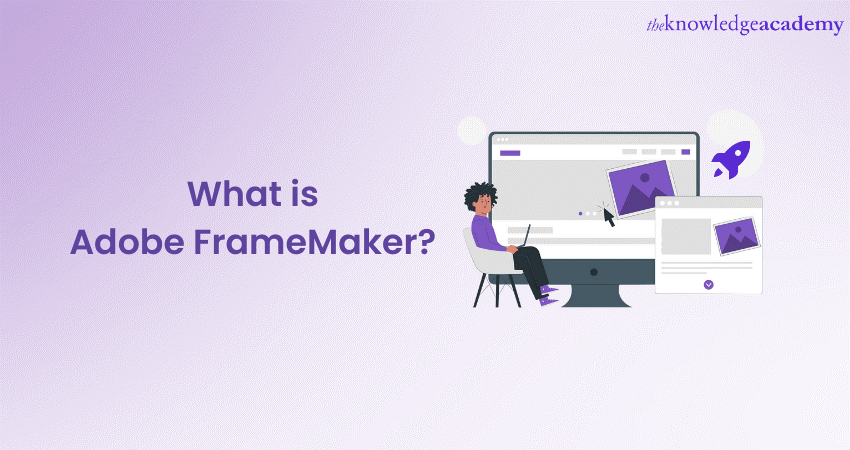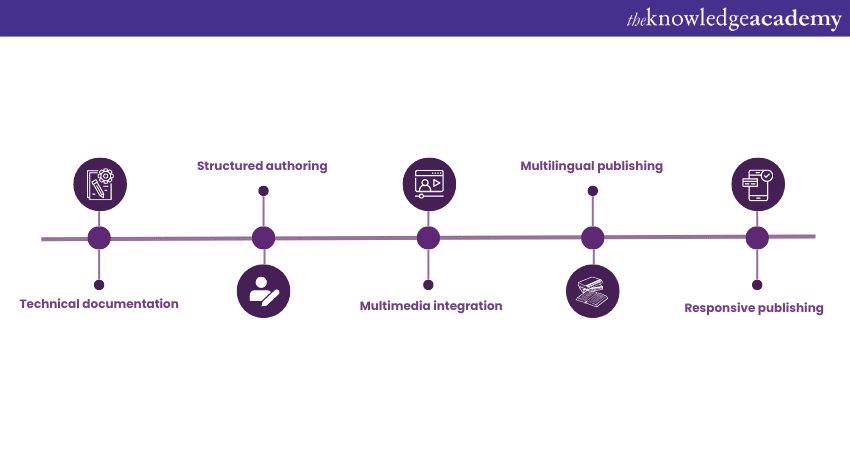We may not have the course you’re looking for. If you enquire or give us a call on +48 221041849 and speak to our training experts, we may still be able to help with your training requirements.
Training Outcomes Within Your Budget!
We ensure quality, budget-alignment, and timely delivery by our expert instructors.

If you are interested in Digital Publishing and content creation, then you need to learn about Adobe FrameMaker. What is Adobe FrameMaker and why do you need it? It's a specialised platform tailored for technical documentation, structured authoring, and large-scale content management. It is also used as a Publishing Tool by many businesses and professionals.
According to 6sense, over 1910 companies around the world, tracked by them, have used FrameMaker as e-books and Digital Publishing software tools. It is your go-to solution for large-scale documentation and structured authoring. You will have your best time creating your digital content. In this blog, you are going to learn What is Adobe FrameMaker, its purpose, features and benefits. Read ahead to learn more!
Table of Contents
1) What is Adobe FrameMaker?
2) What is Adobe FrameMaker used for?
3) Features of Adobe FrameMaker
4) Benefits of Adobe FrameMaker
5) Conclusion
What is Adobe FrameMaker?
Adobe FrameMaker is a document processing software primarily designed for writing and editing large and complex documents. It also includes structured documents. This FrameMaker's power truly shines in technical documentation, where the precision, consistency, and structure of content are paramount.
It can handle vast and varied content types—be it text, graphics, or multimedia elements—with aplomb. Moreover, it supports XML and Darwin Information Typing Architecture (DITA). This FrameMaker also facilitates structured authoring, which is a mode of writing that organises content into distinct, reusable components.
It is also adaptable for multilingual publishing. As businesses become more global, the need for documentation in multiple languages has surged. FrameMaker caters to this demand effortlessly, allowing content creation and dissemination in diverse languages without compromising on formatting or style. Its integration potential with other Adobe products, like Adobe Acrobat and Adobe Captivate, offers a seamless content creation and distribution experience.
What is Adobe FrameMaker used for?
Now you will learn how you can use this multi-faceted Publishing Tool in this section. The following points are:

1) Technical documentation: FrameMaker excels in creating comprehensive technical manuals, user guides, and instructional booklets. Its robust architecture can handle extensive volumes of content without compromising on speed or efficiency.
2) Structured authoring: It supports XML and DITA, which are crucial for structured content creation. This also ensures consistent formatting, allows for content modularisation, and facilitates easy content reuse across different platforms or documents.
3) Multimedia integration: Beyond textual content, FrameMaker enables seamless integration of graphics, 3D models, videos, and other multimedia elements. This multimedia inclusion enhances the quality and interactivity of documents, making them more engaging for the readers.
4) Multilingual publishing: As the business landscape becomes increasingly global, there's a need for content in multiple languages. FrameMaker rises to this challenge, allowing authors to write, format, and publish content in numerous languages, ensuring consistent presentation and layout.
5) Responsive publishing: With the proliferation of devices like smartphones and tablets, content must be adaptable. It also produces responsive HTML5 content that's optimised for various screen sizes. This ensures a consistent reading experience regardless of the device used.
6) Content personalisation: Tailoring content to specific audience segments enhances user experience. With FrameMaker's content filtering features, you can help the readers view content personalised to their specific needs, roles, or preferences.
7) Collaborative authoring: This software supports real-time reviewing and commenting, which is pivotal in today's collaborative work environments. You can help multiple users simultaneously contribute, review, and finalise content. This helps in enhancing team productivity.
8) Template creation and use: To maintain brand consistency and standardised layouts, FrameMaker offers template creation and application functionalities. This will help you ensure uniformity in design and content presentation across various documents.
9) Integration with Adobe Suite: FrameMaker boasts seamless compatibility with other Adobe products like Adobe Acrobat, Adobe Captivate, and Adobe Experience Manager. This integration streamlines the content creation, editing, and publishing process, thereby providing you with a cohesive workflow.
Boost your career with Adobe Training! Learn essential skills and turn your passion into expertise.
Features of Adobe FrameMaker
By learning the features of Adobe FrameMaker, you will be able to use this Publishing Tool more efficiently. Let’s discuss these points:
1) Structured authoring: One of FrameMaker's standout features is its support for structured authoring using XML and DITA. This enables authors to create content in a standardised, organised manner, ensuring that large volumes of information are consistently formatted and easily updatable.
2) Responsive HTML5 publishing: In the age of mobile devices, the ability to create content that seamlessly adapts to various screen sizes is crucial. FrameMaker provides tools to produce responsive HTML5 layouts, ensuring that documents retain their design integrity across different devices.
3) Multilingual support: FrameMaker shines in its ability to handle multilingual content. Authors can effortlessly create, format, and publish content in multiple languages. An integrated dictionary and hyphenation for over 50 languages further streamline the content creation process.
4) High-quality PDF output: FrameMaker's advanced Portable Document Format (PDF) output capabilities mean that documents can be exported with the highest quality, maintaining font integrity, layout, and interactive elements.
5) Unparalleled scalability: It is designed to manage massive documents with ease. Whether it's a comprehensive user manual or a multi-chapter book, this software's architecture ensures smooth performance and efficient memory management.
6) Template-driven workflow: Consistency is key in professional documentation. FrameMaker offers a robust template creation and management system. If you are an author, then you can define styles, formats, and layouts in templates and apply them uniformly across various documents.
7) Interactive elements integration: Beyond static content, FrameMaker facilitates the inclusion of interactive elements like hyperlinks, cross-references, tables of contents, indexes, and footnotes. This enhances your experience and navigability.
8) Rich multimedia support: Documents today are more than just text. FrameMaker accommodates the integration of multimedia elements such as graphics, videos, 3D models, and more. This integration is done by making documents more engaging and comprehensive.
9) Real-time collaboration: Teamwork is pivotal in content creation. FrameMaker's collaboration tools allow multiple authors to work simultaneously on a document. It helps in completing the document with real-time reviewing, commenting, and change tracking.
10) Customisable user interface: FrameMaker boasts a user-friendly interface that's highly customisable. Users can tailor their workspace according to their preferences, enhancing productivity and ease of use.
Master Adobe FrameMaker with our Adobe FrameMaker Training. Learn to create and manage complex documents efficiently. Elevate your skills today!
Benefits of Adobe FrameMaker
Let us discuss now the benefits of using Adobe FrameMaker:
1) Efficiency in handling large documents: Unlike some other software, FrameMaker is specifically designed to handle large, intricate documents. This makes sure that the software remains stable and efficient, even when managing extensive content, preventing crashes or slowdowns.
2) Structured authoring capabilities: One of the standout benefits is its ability to support structured authoring using XML and DITA. This ensures standardised content creation, facilitating consistent formatting and allowing easy content updating without compromising on design integrity.
3) Multi-device responsive output: With the proliferation of devices, content must be readable everywhere. FrameMaker's capability to produce responsive HTML5 output means content looks impeccable on desktops, tablets, or smartphones, enhancing your experience.
4) Streamlined multilingual publishing: Global businesses require content in multiple languages. FrameMaker simplifies this by enabling content creation in various languages. This also ensures consistent layout and design irrespective of the language, reducing time and resources in translations.
5) Unified content workflow: With its tight integration with other Adobe products and third-party applications, FrameMaker offers a seamless content workflow. The workflow begins from creation and editing to publishing and distribution.
6) Enhanced team collaboration: Modern documentation often involves multiple stakeholders. Its collaborative tools, such as real-time reviewing and commenting, ensure that teams can work together efficiently, reducing time to market for publications.
7) Consistency through templates: Brand and design consistency is crucial in professional documents. FrameMaker's robust template system ensures that content remains consistent across various documents, enhancing brand image and professionalism.
8) Interactive content creation: Engaging readers requires more than just text. FrameMaker's ability to embed interactive elements like videos, 3D models, and hyperlinks ensures that documents are not only informative but also engaging.
9) Content reusability: The ability to define and reuse content segments across documents is a massive advantage. It not only ensures consistency but also significantly cuts down content creation time.
10) Robust security features: For sensitive or proprietary content, security is paramount. FrameMaker offers robust security features, ensuring that content remains protected from unauthorised access or modifications.
Conclusion
Adobe FrameMaker stands as an exemplar in professional documentation. It combines user-centric design with advanced capabilities. If you are aiming for precision, consistency, and efficiency in your publications, FrameMaker emerges as the definitive choice. Understanding What is Adobe FrameMaker will help you utilise this digital tool to its full potential.
Attain in-depth knowledge about graphic design with our Adobe Illustrator Training.
Frequently Asked Questions
Upcoming Office Applications Resources Batches & Dates
Date
 Photoshop Course
Photoshop Course
Wed 27th Nov 2024
Wed 22nd Jan 2025
Wed 12th Feb 2025
Wed 19th Mar 2025
Wed 16th Apr 2025
Thu 29th May 2025
Wed 18th Jun 2025
Wed 23rd Jul 2025
Wed 13th Aug 2025
Wed 17th Sep 2025
Wed 15th Oct 2025
Wed 19th Nov 2025
Wed 10th Dec 2025







 Top Rated Course
Top Rated Course



 If you wish to make any changes to your course, please
If you wish to make any changes to your course, please


